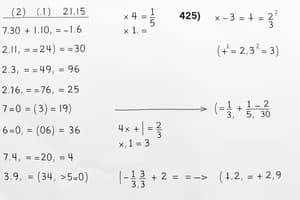Podcast
Questions and Answers
What initial step should you take when trying to factor an expression?
What initial step should you take when trying to factor an expression?
Always start by identifying common factors.
In factorization, how can you handle expressions with four terms?
In factorization, how can you handle expressions with four terms?
Pair them wisely and use the grouping method to identify common elements.
What pattern should you recognize when dealing with the expression $a^2 - b^2$?
What pattern should you recognize when dealing with the expression $a^2 - b^2$?
It can be factored using the difference of squares formula: $(a - b)(a + b)$.
How can you adjust terms if a direct factorization isn't possible?
How can you adjust terms if a direct factorization isn't possible?
What must be ensured when factorizing three-term expressions?
What must be ensured when factorizing three-term expressions?
Give an example of pulling out a common factor from an expression like $3a - 7b$.
Give an example of pulling out a common factor from an expression like $3a - 7b$.
When using the grouping method, what do you need to be cautious about?
When using the grouping method, what do you need to be cautious about?
What should you maintain when applying factorization formulas?
What should you maintain when applying factorization formulas?
Flashcards are hidden until you start studying
Study Notes
Factorization Rules
- Factorization involves simplifying expressions by finding common factors or using formulas.
- Always look for a common factor first; if none exists, consider pairing terms or applying formulas.
- In case of four terms, factor them by grouping pairs.
Common Factor Extraction
- A common factor can be a number, variable, or expression encapsulated in brackets.
- For example, from
3a - 7b, a common factor isaleading to3 - 7(b/a).
Grouping Method for Four Terms
- When dealing with four terms, pair them wisely to identify common elements.
- If
x + aappears, factor outato simplify the expression.
Notable Cases with Four Terms
- For expressions like
a³ + a, factor by taking outa. - Adjust signs when extracting common factors to ensure accuracy.
Applying Formulas
- Recognize patterns such as the difference of squares:
a² - b² = (a - b)(a + b). - Apply formulas systematically while ensuring the expression remains balanced.
Special Cases and Adjustments
- Adjust terms under different scenarios; if an expression does not easily allow factorization, consider rearranging terms or expanding.
- If no common factors are present, expanding might yield usable terms for further manipulation.
Handling Three-Term Expressions
- For three-term expressions, ensure the first and last terms are squares (e.g.,
16x² + 3a²). - Use the squared term formula to potentially simplify expressions.
Example Problems
- In expressions like
4x² + 51x - 54, factor out the common term, analyze potential squares, and apply the necessary formula. - Always maintain checklists during factorization: Identify terms, common factors, necessary formulas, and balanced signs.
Summary of Factorization Strategies
- Always start by identifying common factors.
- Utilize grouping for four terms.
- Recognize squares and patterns for simplifying three-term expressions.
- Ensure to balance signs to maintain accuracy in simplification.
Concluding Notes
- Continually practice factorization with diverse examples to enhance understanding.
- Engage with peers for discussions to solidify learning and explore multiple solutions.
- Regular feedback is crucial for improvement and deeper comprehension of concepts.
Factorization Overview
- Factorization simplifies expressions by identifying common elements or utilizing specific formulas.
- Begin by checking for common factors; if none is found, consider pairing terms or using established formulas.
Common Factor Extraction
- Common factors can be numbers, variables, or larger expressions; encapsulate them in brackets during extraction.
- For example, in
3a - 7b, the variableacan be factored out, resulting in3 - 7(b/a).
Grouping Method for Four Terms
- When faced with four terms, pair them effectively to find shared elements for factorization.
- If the expression contains terms like
x + a, extractafor simplification.
Notable Cases with Four Terms
- For expressions such as
a³ + a, taking outasimplifies the expression. - Ensure correct sign adjustments during factor extraction to maintain expression accuracy.
Applying Mathematical Formulas
- Recognize essential patterns like the difference of squares:
a² - b² = (a - b)(a + b). - Apply mathematical formulas systematically to keep the expression balanced and correct.
Special Cases and Adjustments
- Be willing to rearrange terms if an expression does not lend itself to straightforward factorization.
- If no common factors exist, consider expanding expressions to find useful components for manipulation.
Handling Three-Term Expressions
- In three-term expressions, check that both the first and last terms qualify as perfect squares (e.g.,
16x² + 3a²). - Use the squared term formula to help simplify these types of expressions.
Example Problem Analysis
- In expressions like
4x² + 51x - 54, identify common terms, check for squares, and apply formulas as needed. - Maintain a checklist during factorization: identify terms, common factors, necessary formulas, and ensure sign balance.
Summary of Factorization Strategies
- Start factorization by pinpointing common factors.
- Use grouping techniques specifically for four-term expressions.
- Recognize squares and patterns within three-term expressions to facilitate simplification.
- Constantly check for balanced signs to guarantee accuracy throughout the factorization process.
Concluding Notes
- Regular practice with varied examples is essential for mastering factorization techniques.
- Engage in discussions with peers to solidify understanding and explore diverse solutions.
- Feedback plays a critical role in enhancing comprehension and improving factorization skills.
Studying That Suits You
Use AI to generate personalized quizzes and flashcards to suit your learning preferences.




